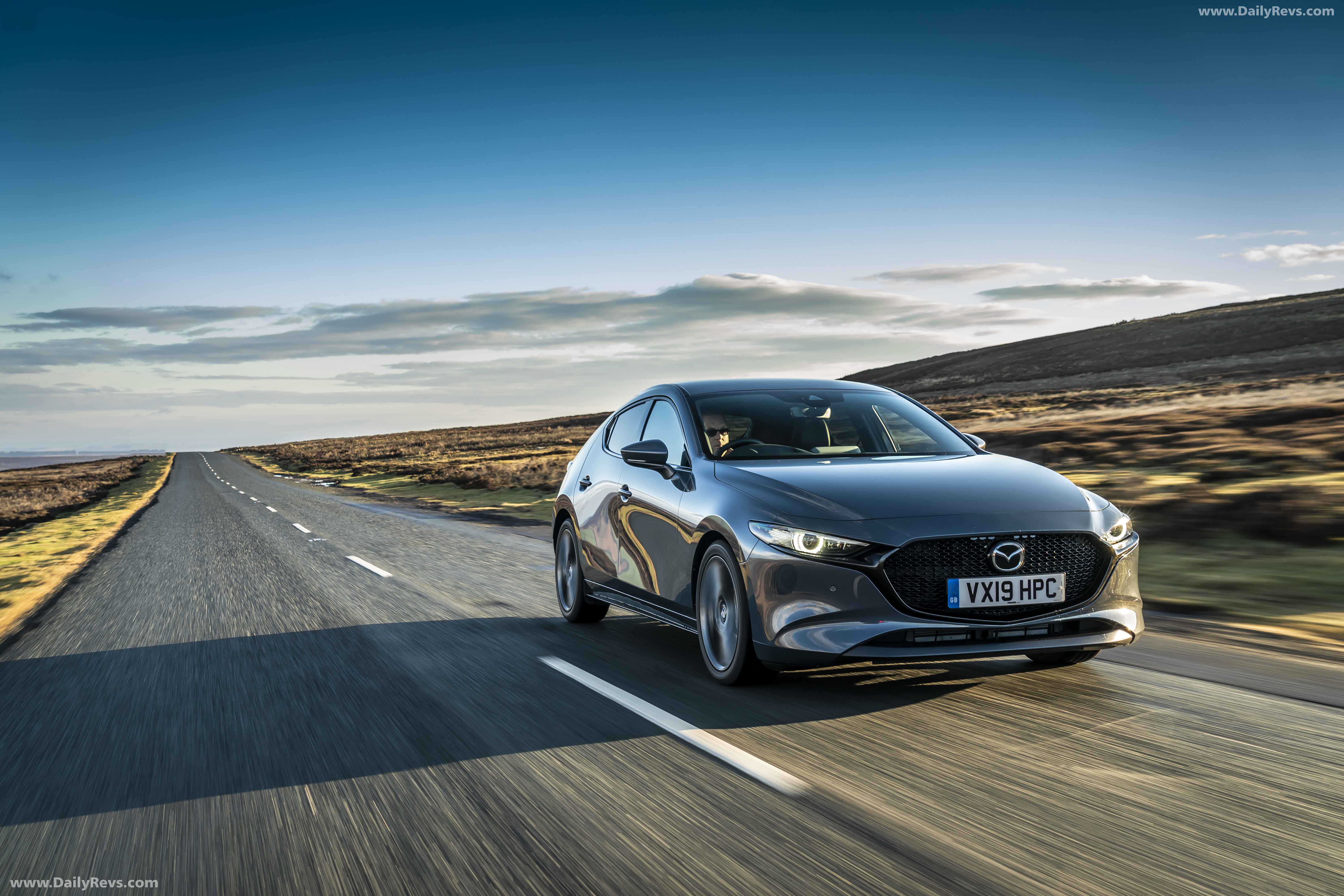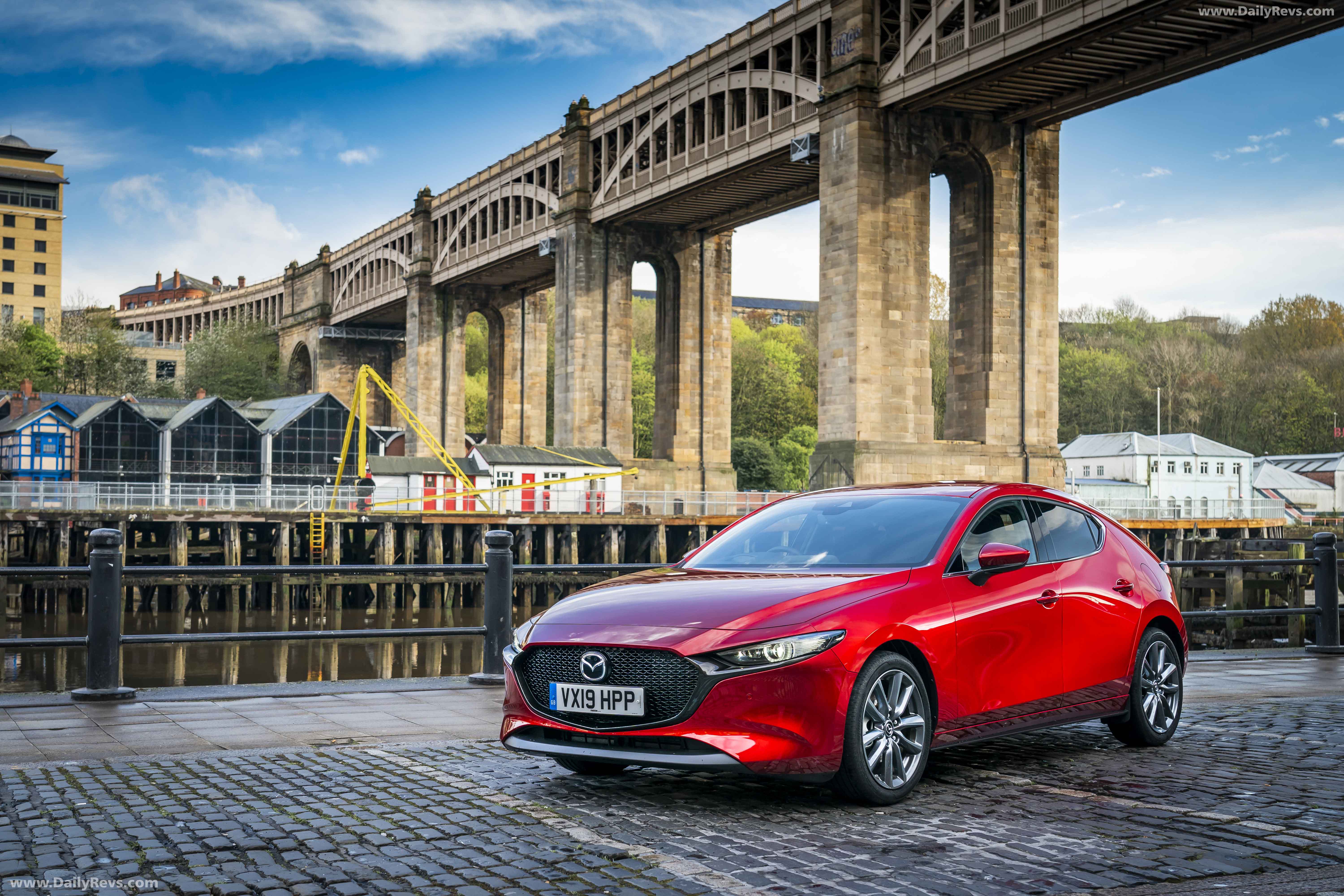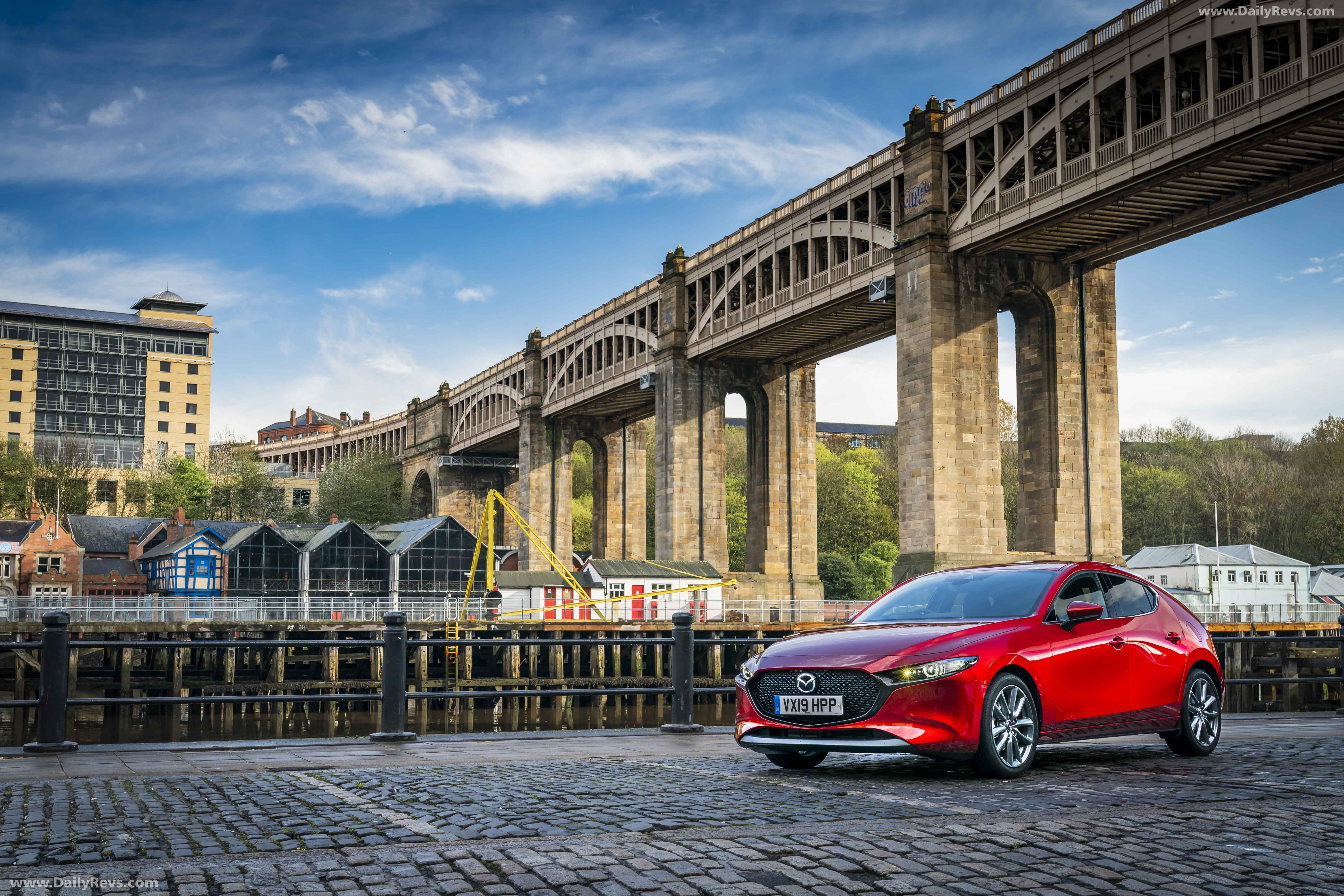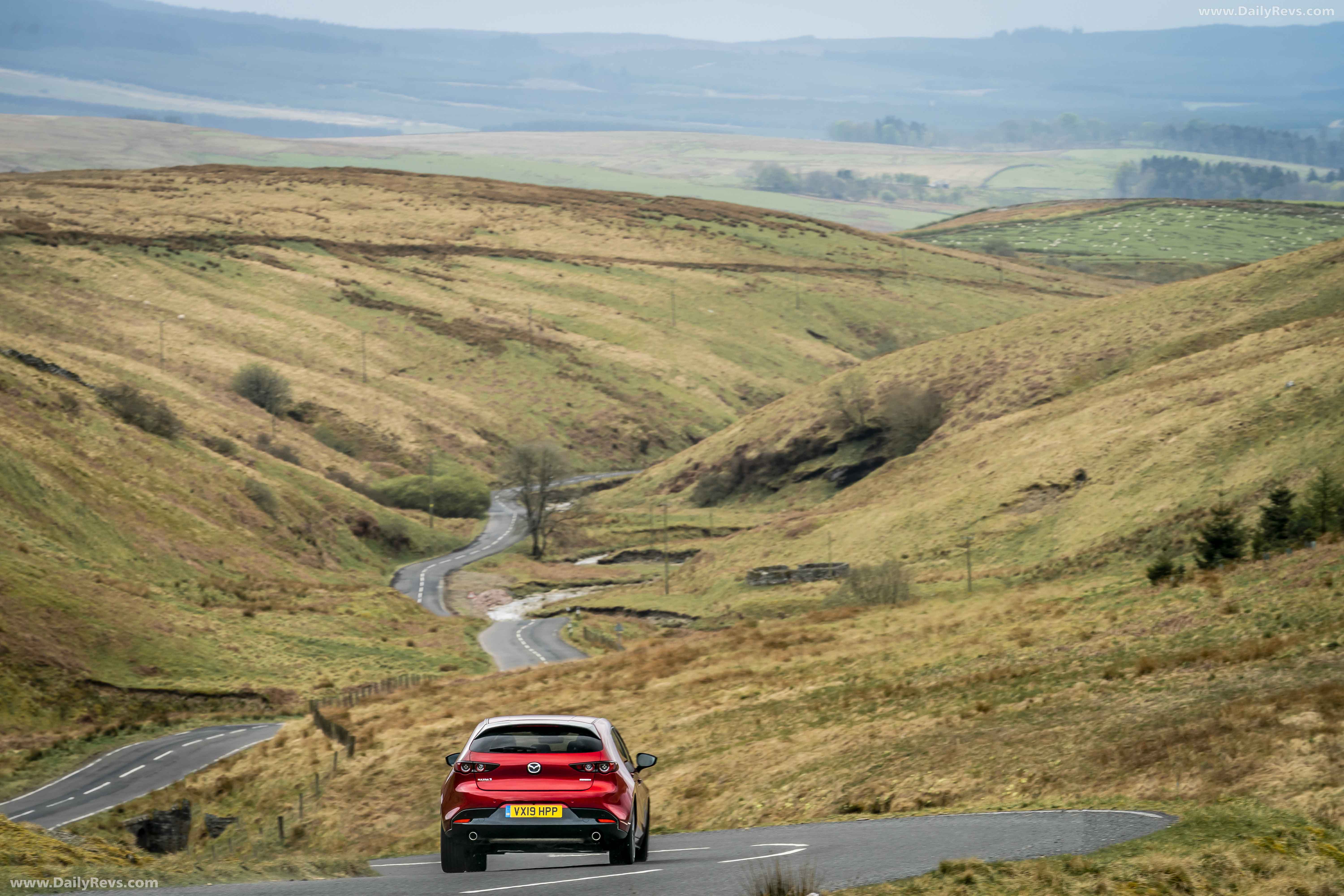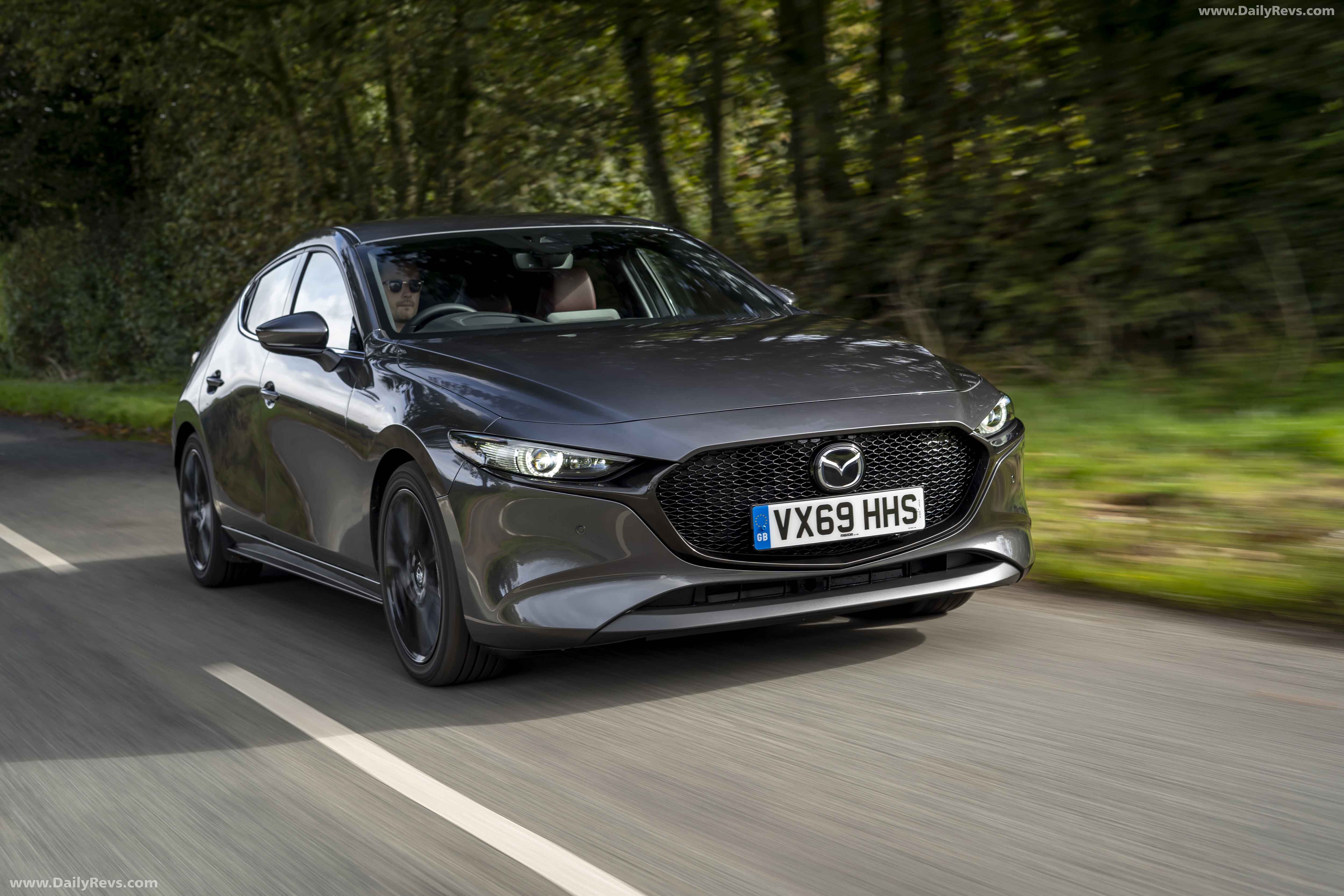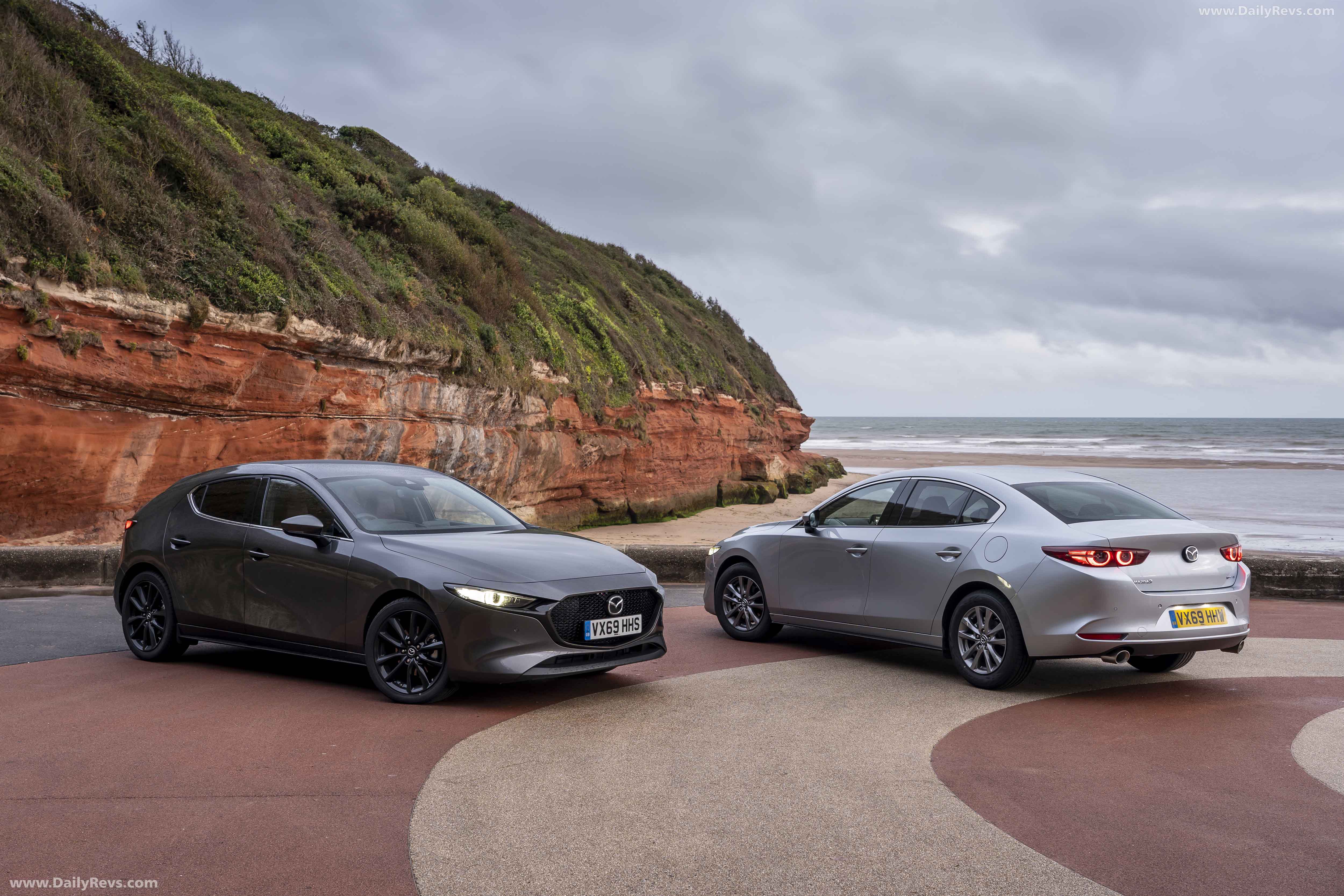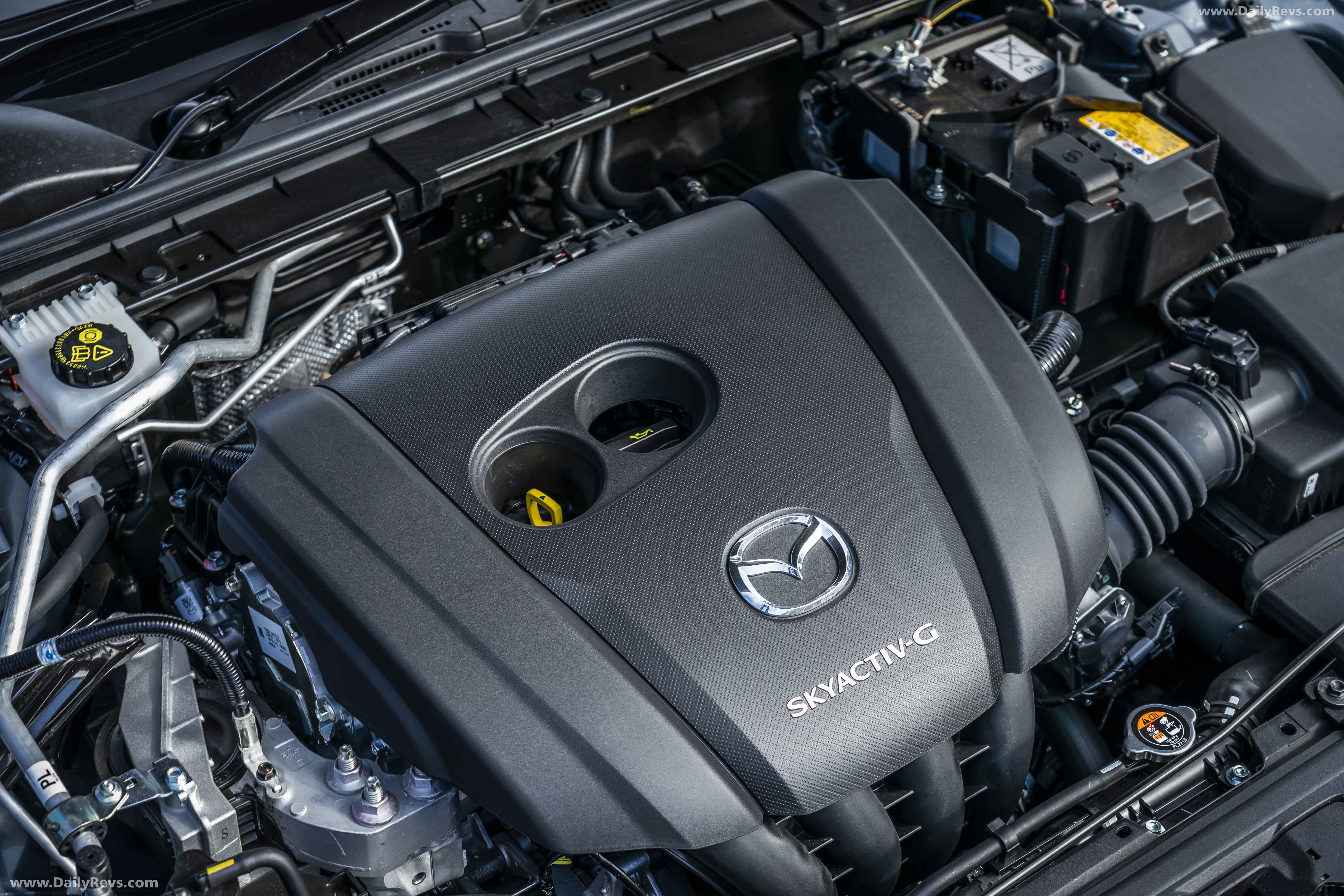2019 Mazda 3 UK
About the Car
2019 Mazda 3 UK
The first of Mazda’s new generation of vehicles to roll off the production line, the All-New Mazda 3 builds on the success of a model that has been enjoyed by family hatchback customers since its original debut in 2003. Launched in 2013, the outgoing third-generation model featured the Kodo: Soul of Motion design that has been a driving force in enhancing Mazda’s design values since the Shinari concept premiered in 2010.
Now, Mazda takes Kodo one-step further, treating the car as a work of art. The result is a new level of sophistication and elegance inspired by the central elements of Japanese aesthetics. The first cars to embody Mazda’s new artful design language were the RX-Vision concept unveiled at the 2015 Tokyo Motor Show and the Vision Coupe concept exhibited at the 2017 show. The evolved concept won global design prizes in 2018, with the Vision Coupe being crowned Concept Car of the Year at the Geneva Motor Show and named Most Beautiful Concept Car of the Year at the Festival Automobile International in Paris. The All-New Mazda 3 is now the first production model to adopt this evolved version of Kodo design.
With clean lines and unique proportions, the sporty hatchback conveys a sense of anticipation and energy that creates a strong emotional appeal. Powerful C-pillars help to achieve a unique rear design in which the cabin and body appear to form a single solid mass. To achieve the car’s signature look, Mazda eliminated all character lines and relied entirely on beautifully curved body panels which reflect the surrounding environment. The dark metallic colour and bold contouring of the signature wing clearly distinguishes it from the Saloon.
Mazda’s designers, engineers and production departments worked hand in hand to bring the full beauty of Kodo design to life in the All-New Mazda 3. One characteristic resulting from the dedication to craftsmanship is the distinctive surface of the body side panels. Depending on the viewing angle and on the way light hits the surface, smooth transitions in the reflections of the body panels are created. Furthermore, the All-New Mazda 3 features a new low-to-the-ground front nose design, which adds greater flow and beauty to the car’s proportions. It was made possible by integrating the functions of parts at the front, thus maximising space efficiency. In addition, the panel edges around the wheel arches are fully folded back on themselves, reducing the gap between tyres and wheel arches to highlight the car’s stylish look.
 The All-New Mazda 3’s updated lamp design shaves away all unnecessary elements to leave only the essence of a light fixture. The resulting round design has an expression of depth and a dynamic presence that is unique to the Mazda brand. The headlamps adopt a simple ring-shape lighting pattern in the centre accented by illumination on the side section. The rear combination lamps feature four round lights with gradations in their illumination that create an appearance of being directed towards the front. In addition, the three-dimensional design of the outer lenses on the hatchback creates a solid look.
The All-New Mazda 3’s updated lamp design shaves away all unnecessary elements to leave only the essence of a light fixture. The resulting round design has an expression of depth and a dynamic presence that is unique to the Mazda brand. The headlamps adopt a simple ring-shape lighting pattern in the centre accented by illumination on the side section. The rear combination lamps feature four round lights with gradations in their illumination that create an appearance of being directed towards the front. In addition, the three-dimensional design of the outer lenses on the hatchback creates a solid look.
Exclusively offered on the hatchback, the newly developed Polymetal Grey Metallic paint combines bright aluminium flakes and opaque pigment, fusing the hard appearance of metal with plastic’s characteristic glossy smoothness. The colour’s tonality changes depending on the light, accentuating the hatchback’s beautiful form. The body colour line-up also includes Mazda’s two signature colours, Soul Red Crystal Metallic and Machine Grey Metallic, along with Deep Crystal Blue, Snowflake White Pearlescent, Arctic White, Sonic Silver Metallic and Jet Black Mica, making a total of 8 colours available for the hatchback version and 7 colours for the Saloon.
The all-new Mazda 3 Saloon marks itself out as a stylish compact executive saloon with its unique proportions and styling. With an identical wheelbase, it is 200mm longer than its hatchback brother, and when it comes to exterior panels it shares just its windscreen and bonnet with the hatchback. Flowing from front to rear in a single motion, the saloon’s smooth surface movements evoke elegance and maturity akin to the Vision Coupe concept car. Its chrome plated grille and unique front bumper adopt a horizontal layout that accentuate a low and wide stance on the road. The combined result is a refined expression of sophistication.
Interior
Mazda’s human-centric approach to vehicle development is all about creating cars built for an effortless, joyful driving experience. The Jinba-Ittai philosophy strives for a completely intuitive and natural connection between car and driver. To achieve this perfect fit, Mazda conducted intensive research studies into how humans move naturally and what causes them stress while driving. The insights gained enable the All-New Mazda 3 to bring out the innate abilities of human beings while avoiding physical or mental tension.
To this end, the cockpit and cabin were carefully designed to provide ease of operation and reduce distracting sources of visual noise. The dials, for example, are lit more brightly while other switches and gauges are more subdued to realise a unified appearance within the cabin at night. Mazda also applied the latest available knowledge and technology in designing the driving position, visibility, Mazda Connect system and audio quality to make the time spent in the car as comfortable and enjoyable as possible.
A natural and relaxed driving posture helps to minimise the burden on the driver’s muscles when operating the vehicle, which in turn reduces fatigue. Mazda’s development engineers therefore focused on seat designs that firmly support the pelvis, as well as pedal layouts and steering adjustments that enable the driver to maintain a natural posture in the All-New Mazda 3.
Numerous adaptations to the centre console prevent any elements from being cramped or awkward to access, while the gear lever and Multimedia Commander are moved forward so they can be operated with the arm at a more natural angle. The armrest is almost twice as long as before to make it easier and more relaxed for the driver to operate the Commander. The height of the centre armrest now matches that of the door trim, further contributing to greater comfort. By relocating the cup holders in front of the gear lever within the field of vision, the driver can comfortably reach for a drink while keeping both eyes on the road.
With the gear lever moved forward and positioned higher on both the automatic and manual transmission versions it’s easier for the driver to move their hand between it and the steering wheel. The shift action is crisp, and it feels as though the lever is being smoothly drawn towards the next position. The manual transmission shift knob now features a flatter top, and the flattened sides help to guide the hand when moving the lever from side to side.
The telescopic steering gains an additional 10mm of movement at either end to offer an adjustment range of 70mm, which delivers more precise control over the driving position adjustment. The All-New Mazda 3 also features a revised seat lifter track. The driver can adjust the seat more smoothly to achieve an optimum seating position and an ideal range of vision. In addition, front seat cushion tilt adjustment is now included as standard. This helps to prevent the angle of the seat from causing the occupant’s thighs to float above the cushion or placing undue pressure on them. The result is firm support that keeps the pelvis in an upright position.
For the All-New Mazda 3, changes in the shape of the A-pillar, as well as improved wiper functionality ensure a clear and continual view of the road. Mazda’s engineers redesigned the thickness and shape of the A-pillar to reduce the amount of area that is obscured. The development team calculated exactly what degree of movement of the neck and eyes is optimal for the driver and then carefully designed each detail of the pillar shape to provide a natural field of view. The new design significantly reduces blind spots ahead of the car, while maintaining a natural driving posture.
To provide the widest possible field of view, the evolved windscreen wipers constantly adjust their operating angle in fine increments. This allows them to clean right up to the edge of the glass and ensure visibility near the driver’s side A-pillar at all driving speeds. The wipers are housed beneath the bonnet, which helps to provide a clear downward view out of the windscreen. In addition, the washer nozzles are attached to the wiper arms so their spray can be wiped away immediately after application. These evolved functions provide the driver with a clearer field of vision in inclement weather.
This focus on driver and car oneness also extends to the infotainment and instrument displays, which have been designed to ensure a unified and optimised look and feel. The 7-inch TFT display at the centre of the instrument cluster presents information clearly and simply for instant recognition. It is aligned with the windscreen-projected colour Active Driving Display, concentrating information critical to driving safety in the upper centre where the driver can see it instantly. Written warnings and indicators are also displayed centrally to help the driver quickly spot irregularities. The change to an LCD panel eliminates the need to show both km/h and mph together, which makes for a much cleaner display. The result is a more attractive appearance combined with greater reading ease.
The All-New Mazda 3 adopts an extended 8.8-inch widescreen centre display, which enables a split-screen view. While the user moves through the menu on the left side of the screen, the right side contains an illustrative display for an intuitive understanding of the available options. Also, navigation and audio information can be displayed together, which increases the infotainment usability. The Active Driving Display, TFT dials and centre display are all designed to present information in a simply fashion with unified fonts to create a pleasing, consistent look.
In order to simply and accurately convey important information in any given situation, the All-New Mazda 3 clearly separates the role of audible alerts and warning displays. Sounds are used to guide the driver’s awareness or convey the level of urgency, while displays describe the situation and how to resolve the problem. Instrument displays use simple, everyday language to clearly instruct the driver on what they need to do to drive safely. Meanwhile, the centre display provides a more detailed explanation of how severely the problem might affect the car and, specifically, how to bring it back to normal operation.
Switch operation for the All-New Mazda 3 was unified based on research in cognitive psychology. Insights into what characteristics evoke a positive response to using switches, regardless of whether they are pushed, pulled, flipped or turned, influenced the design of the vehicle. For maximum operability, steering wheel switches combine the use of both toggle and push-type switches, and the surface of each switch is raised so it is instantly identifiable by touch. The driver also immediately feels the dividing point for upward and downward movement, making the operation of switches more intuitive than ever.
For the All-New Mazda 3, the existing Mazda Connect system was renewed from the bottom up in order to enhance safety and user-friendliness. For instance, greater hardware processing ability and optimised software reduced the boosting time for the infotainment screen by half. Features like the navigation system are ready for use almost instantaneously after the ignition is turned on. Image and sound quality in the All-New Mazda 3 were also greatly improved by digitalising signal transmissions from the camera and audio system. In addition, the performance of the voice recognition system has been enhanced to allow safer and easier operation while driving.
A number of improvements and new features make the All-New Mazda 3’s navigation system more reliable and easier to use. A newly installed 3D gyro sensor with optimised control logic accurately calculates the vehicle’s position even in areas where receiving GPS information is difficult. Through CarPlay and Android Auto, this exact positioning information can also be used with smartphone navigation applications. Additionally, the quality and draw-up speed of 3D maps has been improved, resulting in better map visibility and a better grasp of the user’s surroundings. The new ‘One Box Search’ function allows the user to search for a destination by inputting keywords, just like a normal web search. ‘One Box Search’ predicts the correct destination with less letter input and learns to prioritise previously input destinations.
An equal amount of effort was also applied to ensuring the All-New Mazda 3’s audio experience is first-class. The speaker layout is meticulously designed to provide clear sound in any situation, with the development team placing the bass speakers in the corners where the sound is particularly amplified. Other speakers are positioned and angled where their sound is less likely to be affected by reflected sound.
Furthermore, people are better able to sense the direction from which higher frequency sounds originate. This is why the high-range speakers are positioned on the left and right of the cabin, with the door speakers positioned on the upper section of the door trim. Placing the sound source at a height closer to the occupants’ ears realises a more natural sensation, while also helping the listener to better feel the depth and clarity of the sound.
The standard 8-speaker audio system uses a 3-way layout, with 3L woofers positioned on the sides of the front cowl, 2.5cm tweeters on the sail garnish and 8cm squawkers on the upper section of the front and rear door trim. Standard on GT Sport and GT Sport Tech models, the 12-speaker Bose® sound system adds an 8cm centre speaker, a pair of rear satellite speakers and a custom-designed subwoofer that achieves a fine balance between size and audio quality. It also features custom tuning to provide more powerful bass and higher audio quality. As the new audio system layout does not require the holes in the door panels that previous systems used, sound insulation quality is greatly improved, representing an engineering breakthrough.
Cabin occupants hear a variety of sounds while driving, ranging from street sounds and the car’s exhaust note to music playing from the speakers. Not all are necessary to the act of driving or even particularly enjoyable. However, some of them are absolutely necessary. This is what makes sound management so complex. The philosophy adopted for developing cabin quietness and the audio system for the All-New Mazda 3 was to make the sounds that reach cabin occupants’ ears pleasing. Based on this principle, a great deal of effort went into delivering quality sound that feels natural to the ears.
In addition to the efforts made to deliver class-leading comfort and superb ergonomic simplicity, the standard of materials, meticulous quality and high-class ambiance of the all-new Mazda 3’s cabin takes the interior standards to a level not seen before in a Mazda, while the hatchback’s a 351-litre boot ensures luggage space and practicality are equally impressive. In the Mazda 3 saloon, the 444-litre boot ensures it has the luggage capacity to match its elegant looks.
Skyactiv-X GT Sport and GT Sport Tech saloon models can be ordered with optional Stone Leather, while on hatch versions of this car there’s the opportunity to opt for Burgundy leather.
Engines and Transmissions
The All-New Mazda 3 brings together a long-term vision for sustainability and a desire to deliver an outstanding driving experience. Featuring best-in-class Skyactiv technology, Mazda engines combine the benefits of petrol and electric drives for superior performance and driving pleasure of unprecedented quality.
Mazda’s sustainability strategy is expressed in its ‘Sustainable Zoom-Zoom 2030’ long-term technology development programme. As part of this vision for solving issues that impact the earth, Mazda applies a well-to-wheel philosophy. This end-to-end approach looks at carbon dioxide emissions throughout all stages of fuel extraction and vehicle operation. Viewed from this holistic perspective, internal combustion engines are forecast to continue powering most of the world’s motor vehicles in the future – Mazda will therefore work continually to improve the combustion efficiency and performance of its engines. At the same time, its engineers will gradually integrate electric drive technologies, such as the mild hybrid system used by the Mazda 3’s Skyactiv-G 2.0 engine and Skyactiv-X engine. In keeping with the latest Euro 6d-TEMP emissions regulations, all engines used in the All-New Mazda 3 are homologated according to the requirements of the WLTP/RDE test cycle.
The All-New Mazda 3 is offered with a choice of two petrol engines: 122ps 2.0-litre Skyactiv-G and Skyactiv-X 180ps Spark Controlled Compression Ignition (SPCCI) engine. Across all trims these engines are offered with a choice of six-speed Skyactiv-MT manual or six-speed Skyactiv-Drive automatic transmission.
While it is based on the 2.0-litre petrol engine found in the outgoing third-generation Mazda 3, the latest Skyactiv-G 2.0 high-efficiency direct injection petrol engine found in the All-New Mazda 3 features a host of new features including Mazda’s new Mazda M Hybrid system. The result is strong dynamic performance combined with excellent fuel economy and low particulate matter exhaust emissions. The unit develops 122 PS at 6,000 rpm and maximum torque of 213 Nm at 4,000 rpm. With a manual gearbox, it combines a combined fuel consumption of 44.8-45.6mpg with CO2 emissions of 117-119g/km – depending on trim/wheel size.
Compared to previous iterations of the engine, an upgraded piston skirt and optimised oil ring profile reduce mechanical friction, while the coolant control system promotes quick engine warm-up to reduce fuel consumption. Combustion noise has been refined and enhanced efficiency achieved through the optimisation of the piston top profile and multi-stage injection. And high pressure fuel atomisation from the injectors increases combustion efficiency by preventing fuel adhesion to the combustion chamber walls. On top of that, increased torque across the rpm range delivers the dynamic performance enhancement you’d expect from Mazda.
Another first for the All-New Mazda 3 is cylinder deactivation. Fuel economy in the evolved Skyactiv-G 2.0-litre is increased by virtually shrinking the displacement of the engine when possible. The system automatically switches between two-cylinder and four-cylinder operation depending on the driving conditions. Thus, the system shuts down cylinders one and four in light-load situations, such as when cruising at a constant speed. This reduces pumping loss and mechanical resistance. Airflow intake volume, fuel injection rates and ignition timing are precisely controlled to make the switch smooth. The driver is able to enjoy fuel savings without any noticeable change in the feel of driving the car.
Further adding to the efficiency of the All-New Mazda 3, Mazda’s new Mazda M Hybrid system is standard on the Skyactiv-G and Skyactiv-X engine. A compact and highly efficient 24V mild hybrid set up, the system minimises fuel consumption and supports greater gains in fuel economy by recycling energy recovered during deceleration and powering an electric motor that assists the engine. A belt-driven integrated starter generator (ISG) converts the kinetic energy recovered during deceleration into electric power and stores it in a lithium-ion battery with a capacity of 600kJ. The system then uses a DC-DC converter to convert the power to the appropriate voltage and supplies it to the car’s electrical equipment. The lithium-ion battery is mounted between the wheels to minimise any effect on interior space while helping to optimise weight distribution and contributing to collision safety. In addition, the Mazda M Hybrid system supports extended engine off for increased fuel economy.
Even better, the Mazda M Hybrid system not only enhances the car’s environmental performance but also ensures better drivability. When the car is starting, accelerating or coming to a stop, transitions feel smooth and natural. By substituting engine torque for motor torque, the hybrid system can reach the same acceleration as petrol engines while using less fuel. Furthermore, engine speed is promptly adjusted during upshifts in order to enhance the driver’s subconscious clutch operation. Thus, the driver enjoys all the benefits of a mild hybrid without any sacrifices in terms of driving pleasure.
A world first, Mazda’s Spark Controlled Compression Ignition SPCCI Skyactiv-X engine makes its debut in the All-New Mazda 3 and is expected to account for 60 per cent of UK sales, thanks to its combination of power, low Co2 and economy. Key to its operation is the use of a highly lean and emissions-efficient air to fuel mix, and the ability for the engine to switch seamlessly between conventional spark compression and combustion ignition, by using the spark plug to trigger both types of compression in different ways.
A series of injections first flood the combustion chamber with a lean mixture of fuel and air during the intake process, then a precisely injected richer zone of atomised fuel is added directly around the spark plug during compression. Because of the high 16.3:1 compression ratio, the first charge is close to spontaneously combusting anyway, and the injection of the richer mix creates an ignition in the local zone around the spark plug, which in turn increases pressure in the rest of the combustion chamber to the point where compression ignition occurs and the lean mixture ignites.
This SPCCI operation occurs during light load situations ensuring that the low fuel lean running condition improves economy and reduces emissions; however when the driver asks for more power the engine seamlessly switches to normal ‘stoichiometric’ fuel-air mixture of 14.7:1, while conventional combustion is only used under high engine loads and during very cold starts. The use of a spark plug to control compression ignition also avoids issues with knocking and unstable combustion.
The cleverness of Mazda’s SPCCI engineering is that the Skyactiv-X engine operates in its most efficient mode for more than 80 per cent of the time, delivering improved fuel consumption, lower emissions and more torque than the Skyactiv-G engine. Combining some of the advantageous elements of both petrol and diesel engines, plus C02 emissions as low as 96g/km with the Sport trim saloon, Skyactiv-X offers performance and environmental credentials, making it a great option for customers coming from petrol or diesel cars.
Driving
The first car based on Mazda’s next generation of Skyactiv-Vehicle Architecture, the all-New Mazda 3 takes handling, ride quality and refinement standards to a new level for a Mazda hatchback. Every element from the body, tyres and suspension has been developed to ensure that Mazda’s famous ‘Jinbai Ittai’ sense of oneness between car and driver is more finely balanced than ever before.
This laser focus on delivering an engaging driving experience begins with the body and chassis of the All-New Mazda 3, which marks the debut of Mazda’s latest Skyactiv-Vehicle Architecture. Featuring a body concept, which is based on a straight framework and continuous ring structures, the latest Mazda 3 has new front-to-back connections that complement the vertical and lateral connections of the previous body to form multi-directional ring structures. These increase rigidity while reducing lag in the transmission of energy, which helps to maximise the function of the dampers and tyres.
The new multi-directional ring structures make it possible to concentrate energy input from the road surface in specifically chosen locations. A newly developed damping structure employed in the locations where the energy is concentrated serves as a buffer material that absorbs energy. This effectively reduces vibration that would otherwise cause noise, and it does not increase vehicle weight.
Even better, the All-New Mazda 3’s advanced and stiff chassis has allowed for a suspension system that delivers better communication of road inputs and improved ride quality. Designed with the aim of smoothing forces to the sprung mass, the suspension continues to use an evolved version of MacPherson struts in the front and a newly developed torsion beam set-up in the rear. Specific measures include the adoption of bushings with a new spherically shaped internal structure that makes the suspension respond to input by moving appropriately in the desired direction. In addition, the shortened distance between the lower arm front bushings and ball joints increases longitudinal rigidity in response to lateral input. One result is that it suppresses front-rear movement and supports rapid, lag-free transmission of the input.
The suspension geometry was also redesigned, reducing the amount of steering direction change in relation to suspension stroke to realise more linear movement while cornering. The rear torsion beam adopts a new structure that features different diameters at its centre and outer sections. This effectively increases the rigidity of the rear tyre mounts, which enhances the vehicle’s response.
Braking performance has been developed with the aim of improved stopping performance and pedal feel. Part of the innate connection needed for ‘Jinba-Ittai’, brake pedal feedback was a key focus, with the engineering team working to ensure it’s easy for the driver to sense when the brakes start engaging. This means that they can easily adjust the rate of deceleration by backing off the pedal and it achieves a high level of rigidity that is maintained for as long as the brakes are firmly applied. Thus, the structure of the brake callipers was redesigned and the movement of the piston seals that push the brake pads optimised. The new design maintains constant clearance between the brake pads and brake discs, regardless of whether the brakes are lightly or firmly applied. This reduces rolling resistance and significantly improves controllability. Mazda also paid careful attention to the muscle movement associated with operating the brake pedal. The pedal parts were redesigned to effectively leverage the movement of only those muscles best suited to pedal operation, which results in reduced fatigue and greater control.
Equal efforts were applied to other key driver engagement factors such as steering feel and weighting, plus the shift action of the gearbox. Even the Mazda M Hybird system was engineered to adjust engine speed during upshifts to deliver a smoother shift and enhance the driver’s subconscious clutch operation.
With prolonged exposure to noise, vibration, and harshness (NVH) a cause of driver fatigue and passenger discomfort, improved refinement was another key pillar of the development concept for the All-New Mazda 3. Mazda’s engineers optimised parts structures and conducted human research studies to not only reduce noise, but also control the fluctuations in and direction of sounds throughout the cabin.
The All-New Mazda 3 marks Mazda’s first application of a ‘two-wall’ structure, which leaves space for air between the floor carpeting and body panel beneath it and greatly improves insulation quality. The two walls are designed to match the characteristics of the fibre material attached to the carpet. This increases efficiency without adding weight. Furthermore, the amount of fibre material on the underside of the floor carpet was tuned to its specific location to achieve optimum density across the entire floor. The number of holes in the carpeting was also reduced wherever possible, while all remaining holes were virtually covered by relocating surrounding parts.
Another feature first introduced in the All-New Mazda 3 is a seal inside the parting lines between the roof panel and boot hatch. This significantly reduces noise caused by wind blowing into the gap. As a result, rear seat occupants experience a far quieter ride when travelling at motorway speeds. To further reduce road noise and vibration, the sound-absorbing headliner and floor mats in the All-New Mazda 3 quickly suppress high-frequency noise when the road surface changes from rough to smooth.
Tyres with optimised vertical spring action likewise absorb vibrations to help keep changes in the road surface from being transmitted to the ears of cabin occupants. In addition, engineers greatly increased the rigidity of the passageways through which vibration is transmitted from the tyres to the car’s suspension and body. This reduces the actual existence of vibration, which in turn minimises the amount of noise that cabin occupants perceive.
Other NVH improvement measures include optimisation of the engine control system and engine mounts to suppress unpleasant vibrations during i-stop operation. Of particular note is the belt-driven ISG used by the Mazda M Hybrid system of the Skyactiv-G 2.0 engine. When stopping, it enables the system’s motor to move the pistons to a position where they will start again smoothly, regardless of the operating environment.
Matched exclusively to the Skayactiv-X engine the All-New Mazda 3 hatchback is offered with Mazda’s latest intelligent all-wheel drive system – marking the first-time Mazda has offered a four-wheel drive option in this sector since the 323 AWD. Designed to deliver grip, handling agility and driver confidence, while at the same time ensuring excellent fuel economy, Mazda’s latest i-Activ AWD system stays true to the spirit of Jinba Ittai by responding to driver’s intentions regardless of road conditions.
In addition to always being ready to handle rain, snow and slippery conditions, Mazda’s AWD system contributes to smooth acceleration and cornering on dry roads, enhancing the already dynamically accomplished Mazda 3 chassis. The balance between front and rear tyre grip is constantly controlled to find the perfect balance between grip and efficiency, to achieve this the system continuously calculates and adjusts the amount of torque sent to the rear wheels in order to prevent slip at the front axle. Working in harmony with G-Vectoring Control (GVC) to control torque in response to road condition, throttle position and steering input, the system ensures grip is delivered seamlessly when needed.
Equally, important is the fact that drive isn’t sent to the rear wheels when it isn’t needed thereby ensuring excellent efficiency. Fuel economy is also enhanced by keeping mechanical loss to an absolute minimum thanks a rubber damper inside the power take-off unit, which greatly reduces fluctuations in input torque sent to the rear axle. Overall, there’s a 60 per cent reduction in overall mechanical loss compared to the previous generation of Mazda all-wheel drive system.
Safety
Representing the very latest evolution of Mazda’s proactive safety philosophy, the All-New Mazda 3 sees the introduction new active and passive safety technologies alongside existing features, all of which put the driver firmly at the centre of a safety.
However, for all the active safety accident avoidance and mitigation systems at the very heart of the All-New Mazda 3 is a body built to protect cabin occupants and pedestrians from injuries should the worse happen. With improvements ranging from an updated body structure to advanced seat design, passive safety is taken to a new-level for a Mazda hatch.
For the All-New Mazda 3, the ratio of ultra-high-tensile steel rated 980MPa or higher has been increased from 3% in the previous model to 30% today. It is also the first car in the world to adopt cold-stamped vehicle body parts made of 1,310MPa-grade high-tensile steel, producing a light yet remarkably strong body structure. This lightweight, high-rigidity body design gives the All-New Mazda 3 a strong architecture capable of resisting impact and a frame structure that effectively absorbs impact energy, thereby reducing the possibility of injury.
By extending the bumper beam on each end and adding a new perimeter beam, the All-New Mazda 3 reduces the force of impact in an offset collision. Upon contact with another vehicle, the perimeter beam effectively guides energy to the load paths, while new paths transmit impact energy towards the rear of the vehicle. In addition, the All-New Mazda 3 adopts a bendable front frame structure that takes the brunt of the impact and gradually absorbs the energy.
Cabin deformation is minimised in a side impact by dispersing energy from multiple directions to the front and rear of the vehicle. The door hinge material is made of 780MPa-grade high-tensile steel, and is also thicker. New reinforcements were added to the rear body section and hot-stamped material adopted on the B-pillars. Adding further strength is the new multifaceted cross-section shape of the material used for the B-pillars, side sills and roof. In the event of a collision from behind, the rear side frames of the All-New Mazda 3 deform in an accordion-style pattern. This makes it possible to double the level of energy absorption efficiency over the previous model without increasing weight.
Improvements to seat, airbag and seatbelt design has also improved passive safety, for example Mazda’s neck injury mitigating front seats are further evolved to even better prevent whiplash. The seat structure and hardness minimise the amount of movement of the occupant’s head, chest and hips in the event of a collision to reduce the chance of neck injury. Specific measures taken by developers include changes to the support structure for the seat slider and support location for the seat lifter bracket. This increases rigidity so the seat’s side frames absorb energy and minimise the amount of reaction needed to return the seatback to its original position. This reduces the chance of the seat causing injury by pushing the occupant’s head forward.
Additionally, the lower mounts for the front seatbelts are now attached to the seat itself. This reduces the amount of slack and allows them to more quickly restrain the occupant in the event of a collision. It combines with the pretensioner and load limiter, which tighten the seatbelt in the initial moment of a collision and subsequently loosen it in a controlled manner, to quickly and gently restrain the occupant and reduce the chance of injury.
The new generation Mazda 3 introduces a knee airbag for the driver’s seat. Included as standard across the range, the new airbag suppresses the forward motion of the driver’s body in the event of a collision, reducing the load that the seatbelt has to bear and contributing to fewer injuries to the driver’s legs, chest and abdomen.
Pedestrian safety was also at the forefront of the development team’s thoughts and the latest Mazda 3 has a new bonnet structure that reduces the amount of deformation upon contact and ensures faster energy absorption. This helps to protect a pedestrian’s head in the event of an accident. The All-New Mazda 3’s front bumper, too, has been adapted and is designed to control how force is applied upon contact with a pedestrian’s legs. By reducing the impact on the knee area, the structure helps to mitigate injury.
As a core model in the line-up, the Mazda 3 has always reflected the latest advances in the company’s vehicle engineering and safety systems and the latest Mazda 3 is no exception. Mazda’s i-Activsense suite of advanced safety technologies helps the driver to be aware of and avoid potential hazards. The All-New Mazda 3 is equipped with three newly developed active safety features: Driver Attention Alert with camera, Cruising & Traffic Support (CTS) and Front Cross Traffic Alert (FCTA). All three of these are standard on the range topping GT Sport Tech model, as is a 360 degree view camera and Rear Smart City Brake Support.
The 360 Degree View Monitor uses a camera system that covers all four sides of the vehicle to display the car’s immediate surroundings. It works with four separate 1.3 megapixel cameras with digital signal transmission in order to achieve high-resolution images.
The Driver Attention Alert monitoring technology uses a camera to observe how attentive the driver is behind the wheel. It monitors how wide open the driver’s eyes are at any given time, the number of times they blink and also the angle of the mouth and face and uses this information to assess their level of drowsiness or fatigue. If the system detects that the driver is falling asleep or is unaware of a possible collision with the vehicle in front, it sounds an alert. In conjunction with the Smart Brake Support (SBS) system, it also shortens the time required for the brake warning to sound.
The system applies both an infrared camera and infrared LED to monitor the driver’s condition day and night. It even functions properly when the driver is wearing sunglasses. Mounted within the centre display’s bezel, the camera’s ability to consistently monitor the driver is not affected by actions such as the driver’s hand movements when operating the steering wheel.
Mazda’s newly developed Front Cross Traffic Alert (FCTA) system detects other vehicles approaching from blind spots and alerts the driver to their presence. New front side radars monitor the left and right front diagonal areas where the driver cannot easily see encroaching vehicles. The system operates when the car is moving forward at speeds of about 6mph or less and helps to prevent a common cause of accidents, cars entering a T-junction with a partially obscured view.
Cruising & Traffic Support (CTS) assists with driving operations and contributes greatly to reducing driver fatigue, fostering a safer and more comfortable driving experience. When the car is stuck in a traffic jam, CTS automatically operates the accelerator and brake pedals to maintain a proper trailing distance between the Mazda 3 and the vehicle in front. In addition, it assists with steering operations to keep the car in its proper lane. The steering control is strictly limited to assisting the driver, so CTS will not steer the car on its own if the driver takes their hands off the steering wheel.
In addition to the three new technologies found on GT Sport Tech models, a number of existing active safety technologies have become newly available or updated, meaning the All-New Mazda 3 has the most extensive standard safety equipment tally yet seen in a Mazda in this segment. Outside of the GT Sport Tech’s additional six safety pack items, all other active safety systems are standard across the entire range.
Blind Spot Monitoring with Rear Cross Traffic Alert, Lane-Keep Assist System and Smart City Brake Support Front, to name just a few items, are all standard across the range. While the inclusion of Mazda Radar Cruise Control as standard across the range improves safety and driver convenience.






















